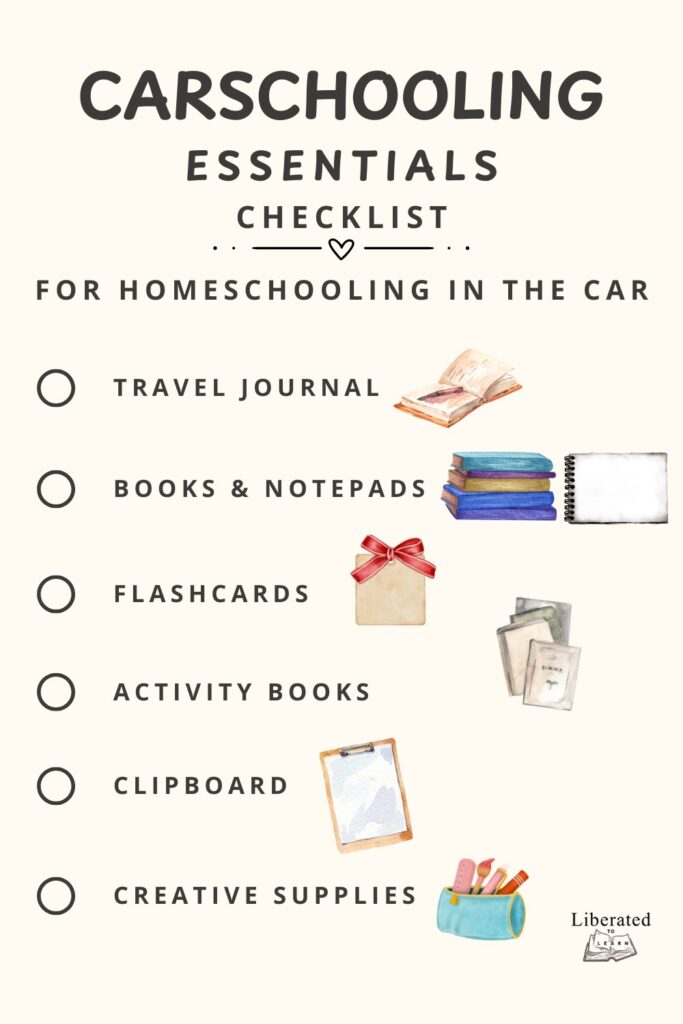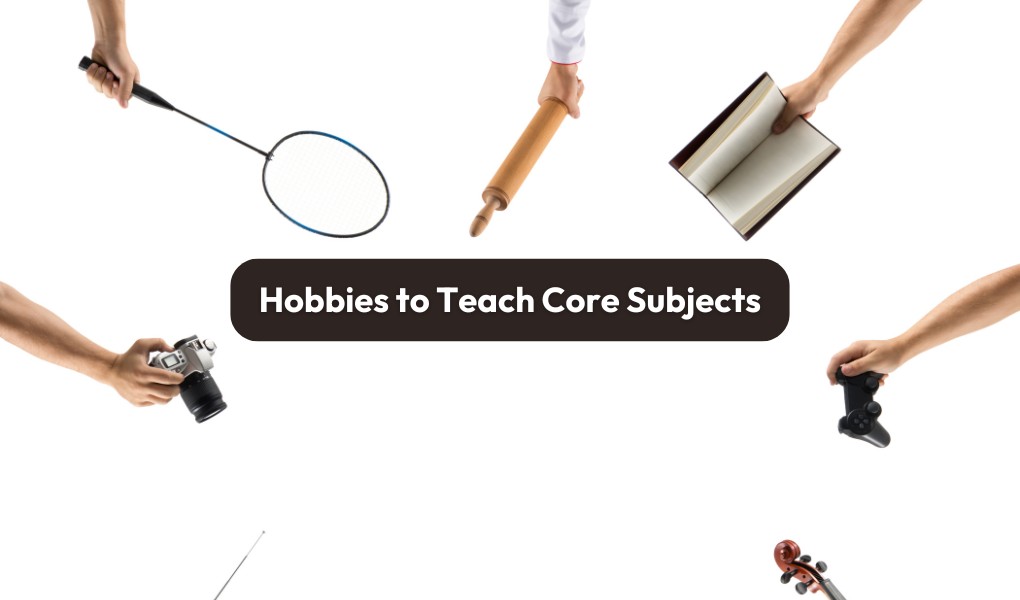To put it simply, carschooling is home educating in the car. It’s the perfect way to homeschool on the go. . .

Contents
Ever heard of carschooling before? Well, neither had I. Although I’d always tried to make car journeys a bit more productive and use trips as learning opportunities, I didn’t know that there was actually a term for it. Now that I think about it, ‘carschooling’ makes a whole lot of sense, and it’s one of the many things that home educators use to their advantage.
I realised that I could provide my daughter with educational value, even whilst being in the driver’s seat. And I could do it with very little! Whether it was a quick errand or a longer trip, we made the most out of driving and took advantage of the time to learn.
Shall we dive more into what carschooling is and how to do it? Let’s go!

What is Carschooling?
To put it simply, carschooling is home educating in the car. It’s the perfect way to homeschool on the go, and it means you can create valuable moments of learning all while sitting in the driver’s seat. Whether it’s a quiz game, looking at flashcards or listening to an educational podcast.
It isn’t about structured or formal-style lessons—it’s about making learning fun and engaging. We all know how boring car journeys can be for kids, but carschooling changes this. It not only gives your child something to do, it makes the time spent sitting in the car productive. It’s also great for busy parents who juggle work and home educating.
How to Start Carschooling
1. Prepare a carschooling kit
The first step to carschooling is preparing a carschooling kit that you can either keep in the car or have ready to go with different materials and resources for each journey. Here are some ideas of what you might want to include in your carschooling kit:
- Books for reading, whether it’s fiction or non-fiction
- A journal for jotting down notes and any observations while travelling
- A pad and colouring pencils for drawing
- Flashcards on any subject
- A whiteboard for things like spelling and maths problems
- Travel puzzle or board game
- Brain teasers, word searches, or Sudoku
2. Come up with interactive games & activities
When homeschooling in the car, you’ll likely want to make it as fun as possible so that it doesn’t feel like tedious learning. The last thing you want is your child feeling like it’s a chore or that they’re made to do it.
The best way to ensure that they’re eager and up for participating is to come up with interactive games and activities that actually make the learning fun. You could:
- Play 20 questions, where you might pick a historical figure or animal etc., and let your child ask ‘yes or no’ questions to guess the answer.
- Create maths equations from car number plates. For example, we see what numbers are on two sets of number plates. If a number plate has the number 1 and 6 on it and another car has the numbers 0 and 9, you could get your child to add, subtract, divide or multiply these numbers together depending on their age and ability.
- Play the ABC game, where you pick a letter and get your child to spot something beginning with the same letter.
- Look out for town and street names on road signs and make new names for them by rearranging the letters.
3. Encourage creativity
Carschooling is much more fun when your child can get creative, and there are so many creative ways to get them learning. You could get your child to come up with a story or create art based on what they see on the car journey. A travel journal is perfect for this too!
4. Use technology but don’t rely on it
The decision to use technology is completely up to you and it also depends on your child’s age too. Tablets and phones can be really useful for podcasts, educational apps, and watching documentaries. I personally wouldn’t rely on them all the time, but they do come in handy and are a way of switching up how your child learns in the car.
5. Use real-life situations as learning opportunities
There is always something to see on a car journey and anything can turn into a lesson, like learning about the weather or reading road signs.You can even make stopping for fuel an opportunity for your child to learn, like working out how much the fuel would cost in total based on the price per litre.
6. Mix it up every journey
To prevent your child from getting bored or knowing what to expect, mix up activities, games, and the things your child uses to learn. If one day they spend the car journey reading or drawing, try an interactive game or quiz next time.
Carschooling Tips and Tricks
Here are some tips and tricks which will make homeschooling in the car much easier!
- Make sure your carschooling kit and other resources are easy for your child to pick up and put down when needed. You could put them in the glove compartment if your child is able to sit in the passenger seat or in the backseat pocket.
- Use a fun way to decide on a topic or activity before the car journey, like picking out of a hat.
- Plan ahead and create activities which will be perfect for the length of time that you are in the car.
- Switch up the resources and interactive games often.
- Find new ways to keep the learning interesting.
- Have snacks and drinks on hand too.
- Don’t worry if your child isn’t in the mood for carschooling and don’t force it.
Homeschool Activities for in the Car (By Age Group)
Carschooling can work for any age, even teenagers (if you can make them feel up to it!). From toddlers to teens, here are some homeschooling activities that you can do in the car.
Carschooling Activities for Ages 2-5
Toddlers are really curious but they tend to have short attention spans, so quick, fun activities work best. Hands-on activities are also ideal.
Identify colours and shapes
Ask your child to spot something in a specific colour and see if they can point out specific shapes. We love doing the car-colour game where we spot and count how many cars there are in the same colour.
Counting games
When in the car, you can count anything! It’s such a fun and easy game for toddlers.
Nursery rhymes and songs
Get that radio on and play some songs! Sing together and encourage your toddler to sing about what they see on the journey.
Animal spotting
See if your child can spot and name any animals, birds or even insects outside the window.
Sensory activities
Take some sensory toys or small activities with you every car journey. You can make these related to certain topics, like making animals out of playdough.
Carschooling Activities for Ages 6-8
At this age, you can include more structured activities and games that introduce the core subjects.
Basic maths problems
Use what’s around you to come up with simple maths problems for your child to solve. For example, you could ask: if there are two blue cars and six silver cars, how many cars are there in total?
Spelling and word spotting
You could get your child to read road signs and spell words related to what you both see on your journey.
Tell stories
Car journeys are the perfect opportunity to make up stories because children get inspiration from the things they see. You could start a story and then let your child add to it.
Listen to fun audiobooks
Play engaging audiobooks that your child will enjoy listening to.
Draw what you see
Encourage your child to draw what they see or pick a topic and get your child to draw things related to the topic.
Carschooling Activities for Ages 9-12
Now you can make the activities a little more complex and really get your child thinking.
More advanced maths challenges
Since you’re in a car, you could start including speed and distance for maths problems. For example, you could ask: If we’re travelling 60 miles per hour and our destination is 120 miles away, how long will it take to get there?
Navigating and reading a map
Teach your child to read a map or navigate using GPS. You can ask them what the fastest route would be and get them to give you directions.
Look out for historical landmarks or interesting architecture
If you know you’re going to be driving past a historical landmark you can explain the history behind it and prepare related activities in advance for your child to do in the car.
Creative writing
Get those creative juices flowing by getting your child to write a poem, story or journal entry based on what they see. Here are some writing prompts!
- Write a diary entry from the perspective of a driver in another car.
- Write a poem inspired by the journey.
- Write a story about three things you’ve seen along the way.
Observe the natural world
By getting your child to observe what’s around them, you can discuss all kinds of things, like the weather and ecosystems.
Carschooling Activities for Teenagers
Discuss current events
Listen to podcasts or audiobooks and have a discussion about them.
Talk about future careers and aspirations
The car provides the perfect opportunity for long conversations, so why not discuss career goals and future aspirations with your teen? Then get your teen to write down their goals and how they plan to accomplish them.
Brainstorm a business idea
You’re never too young to brainstorm the perfect business idea. Let your teen delve into their interests and come up with a business that they’d maybe one day like to create. You can also introduce business plans and budgeting to them.
Research on a road trip
If you’re going on a longer journey, get your teen to research about the destinations you will go to.
Plan a creative project
Whether your teen is interested in art, writing a script, making a sculpture or something equally exciting, get them to do all the planning and preparing in the car so that they can get stuck into it at home.
Benefits of Carschooling
It makes unused time more productive
The time that you spend in a car can easily be wasted, but with carschooling you’ll always get something productive out of it—even if it’s just a short journey.
Prevents boredom
Car journeys can be very boring, especially on long trips or for younger kids who need to be occupied. But carschooling makes the journey a lot more fun and, most of the time, kids do not even realise they are learning.
Learn on the go
Carschooling is the perfect way to homeschool on the go. If you’ve had a busy day or haven’t managed to squeeze in some learning, carschooling gives you the opportunity to catch up and learn whilst travelling.
Encourages interaction and creates engagement
Car journeys are not the most engaging of things. They can either be spent talking all the way or having long silences and daydreaming out the window. Carschooling makes the journey a lot more interactive and encourages your kids to talk to you and engage with activities. It definitely keeps their minds busy too.
Makes kids more observant
Kids become more aware of what’s around them and really take things in a lot more. They may even start to see things differently, come up with new ideas, and gain lots of inspiration simply from the things they see and the activities they engage in.
You can introduce important life skills
You may be in the car but that doesn’t mean you can’t introduce important life skills to your kids. You may not even realise that you’re doing it too! Things like budgeting and map reading are naturally things you would think about and are definitely worth teaching.
It’s ideal for busy parents
Carschooling is great for busy parents because it means they can squeeze in learning time without feeling guilty. As we all know, learning can happen at any time, anywhere!
Essential Checklist for Carschooling

Here are some perfect essentials for homeschooling in the car and when you’re on the go.
A travel journal
Perfect for jotting down notes, making observations, and doodling whilst in the car.
Books and notepads
This is obviously a no-brainer.
Flashcards
To help learn topics like numbers, the alphabets, maths equations, and educational facts.
Clipboard
This comes in really handy for when your child needs a surface to write and draw on.
Activity books
We’re talking word searches, crosswords, brain teasers, and sudoku.
Mini board games and puzzles
Have some travel-friendly board games and puzzles in the car at all times! Here are some suggestions:
- Road trip bingo
- Trivia cards
- Scrabble
Creative supplies
You definitely need a stash of pens, crayons, colours and markers.
Audiobooks
Have a few audiobooks on hand for your child to choose from.
Podcasts
Also create a list of educational podcasts to listen to.
A whiteboard and pen
If you want to save on paper, a whiteboard and pen is ideal and it saves on book space too.
Tablet or smartphone
If you’re happy to use technology, have a tablet or smartphone in the car when using educational apps and watching documentaries.
A charger
A must-have for long trips in case you ever need to charge your tablet or phone.
Headphones
If your child wants to listen to things independently and get into the zone with music, keep headphones on hand.
A lap tray
The ideal alternative to a table for the car.
Maps or atlases
When travelling, you can always rely on a map. They are an essential for learning about navigation.
A dictionary and thesaurus
To help with writing and learning words.
Calculator
For checking the right answers to maths equations.
A water bottle and snacks
To keep your kids hydrated and those hungry bellies satisfied on journeys.
A blanket and pillow
To keep comfy in the car!
First aid kit
Perhaps the most important essential, even if you don’t have to use it! A first aid kit is always recommended to keep in the car.
Ready to give carschooling a try? Start small, experiment with different activities, and watch as learning becomes an exciting part of your child’s journey—both on the road and in life!

m@liberated
Want more from Liberated to Learn?
Subscribe to stay updated about new posts, resources and giveaways!












